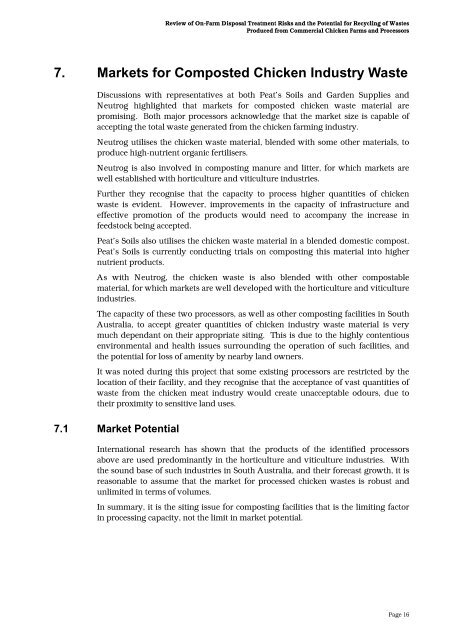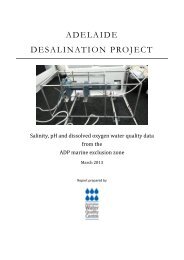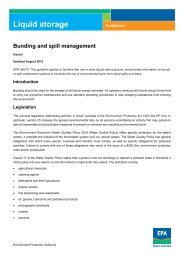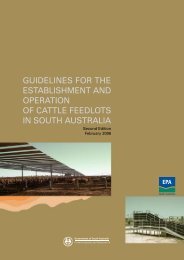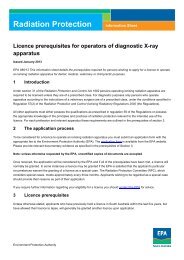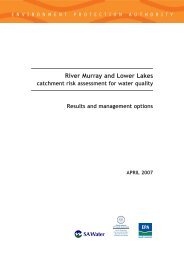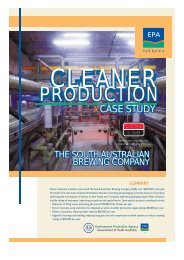Commercial Chicken Farms and Processors - EPA
Commercial Chicken Farms and Processors - EPA
Commercial Chicken Farms and Processors - EPA
You also want an ePaper? Increase the reach of your titles
YUMPU automatically turns print PDFs into web optimized ePapers that Google loves.
Review of On-Farm Disposal Treatment Risks <strong>and</strong> the Potential for Recycling of Wastes<br />
Produced from <strong>Commercial</strong> <strong>Chicken</strong> <strong>Farms</strong> <strong>and</strong> <strong>Processors</strong><br />
7. Markets for Composted <strong>Chicken</strong> Industry Waste<br />
Discussions with representatives at both Peat’s Soils <strong>and</strong> Garden Supplies <strong>and</strong><br />
Neutrog highlighted that markets for composted chicken waste material are<br />
promising. Both major processors acknowledge that the market size is capable of<br />
accepting the total waste generated from the chicken farming industry.<br />
Neutrog utilises the chicken waste material, blended with some other materials, to<br />
produce high-nutrient organic fertilisers.<br />
Neutrog is also involved in composting manure <strong>and</strong> litter, for which markets are<br />
well established with horticulture <strong>and</strong> viticulture industries.<br />
Further they recognise that the capacity to process higher quantities of chicken<br />
waste is evident. However, improvements in the capacity of infrastructure <strong>and</strong><br />
effective promotion of the products would need to accompany the increase in<br />
feedstock being accepted.<br />
Peat’s Soils also utilises the chicken waste material in a blended domestic compost.<br />
Peat’s Soils is currently conducting trials on composting this material into higher<br />
nutrient products.<br />
As with Neutrog, the chicken waste is also blended with other compostable<br />
material, for which markets are well developed with the horticulture <strong>and</strong> viticulture<br />
industries.<br />
The capacity of these two processors, as well as other composting facilities in South<br />
Australia, to accept greater quantities of chicken industry waste material is very<br />
much dependant on their appropriate siting. This is due to the highly contentious<br />
environmental <strong>and</strong> health issues surrounding the operation of such facilities, <strong>and</strong><br />
the potential for loss of amenity by nearby l<strong>and</strong> owners.<br />
It was noted during this project that some existing processors are restricted by the<br />
location of their facility, <strong>and</strong> they recognise that the acceptance of vast quantities of<br />
waste from the chicken meat industry would create unacceptable odours, due to<br />
their proximity to sensitive l<strong>and</strong> uses.<br />
7.1 Market Potential<br />
International research has shown that the products of the identified processors<br />
above are used predominantly in the horticulture <strong>and</strong> viticulture industries. With<br />
the sound base of such industries in South Australia, <strong>and</strong> their forecast growth, it is<br />
reasonable to assume that the market for processed chicken wastes is robust <strong>and</strong><br />
unlimited in terms of volumes.<br />
In summary, it is the siting issue for composting facilities that is the limiting factor<br />
in processing capacity, not the limit in market potential.<br />
Page 16


